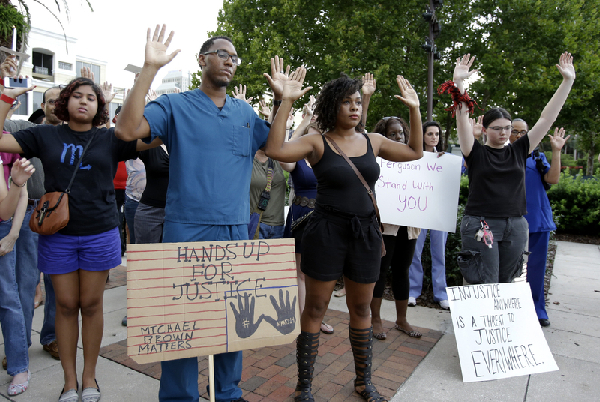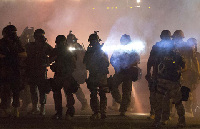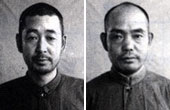Police images fuel outrage in Missouri and beyond
(Agencies) Updated: 2014-08-15 14:53FERGUSON, Missouri - The images are reminiscent of a war zone: Helmeted officers pointing weapons from armored trucks, flash grenades lighting the night sky and tear gas exploding in crowded streets.
 |
|
A group of people hold up their arms during a nationwide moment of silence at a vigil to remember Missouri shooting victim Michael Brown and other victims, Aug 14, 2014. [Photo/IC] |
The ugly clashes between police and protesters in this Missouri city have fueled a torrent of criticism and raised questions about whether the officers' tactics are inflaming the same violence they aim to suppress after the fatal shooting of Michael Brown, an unarmed black teenager.
The protests escalated late Wednesday into smoky chaos after police lobbed tear gas to repel a crowd of about 150 protesters after some had thrown Molotov cocktails and rocks at officers. It was the fourth straight day of street confrontations spurred by Saturday's fatal shooting of the 18-year-old by a white police officer.
 |
| Police shift response to US protests after outcry |
The repeated scenes of police officers wearing military-style camouflage and gas masks and training their rifles on unarmed civilians - some holding their hands up - led critics to condemn the unusual show of force, suggesting it looks more like an Army trying to quell a revolution than a police department trying to keep the peace in Ferguson, a small suburb of St. Louis.
"It's clear what is going on in Ferguson is a complete, hyper-exaggerated, hysterical response on the part of law enforcement," said Thomas Nolan, a former Boston police officer and criminal justice professor of the State University of New York at Plattsburgh. "It's clear that there is no one in charge and no one to corral the officers ... and restrain them from engaging in an unprecedented show of brutal force against civilians. It's horrifying and shameful and a disgrace."
Ferguson Police Chief Thomas Jackson said Thursday that police are trying to balance the public's right to protest with public safety, including the need to keep streets open. But he added, "If firebombs are being thrown, property gets destroyed, shots get fired ... we have to respond to deadly force."
The events in Ferguson were seen as part of a growing trend among police departments around the US










